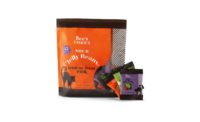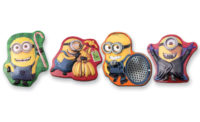Halloween & December Holiday
Candy Review
Candy Review
A look back at fourth-quarter seasonal sales and recommendations for building bigger and better sales in coming seasons
The year 2005 was a good
one for Halloween and December Holiday candy sales, according to
Information Resources Inc. (IRI) data obtained from The Hershey Company and
information provided by the U.S. National Confectioners Association. The
data provides strong insights into seasonal candy sales, and, thanks to
special analyses and custom databases provided by The Hershey Company,
offers useful guidance into growing seasonal candy sales. The custom
database (“defined seasonal aggregate”) employed by Hershey
(and other players in seasonal who develop their own view) is important to
comprehending seasonal sales.
| Season | 2001 | 2002 | 2003 | 2004 | 2005 |
| Valentine | -0.50% | 6.50% | -7.60% | -3.00% | -4.00% |
| Easter | -2.40% | -2.20% | 2.20% | 5.50% | -7.60% |
| Halloween | 0.20% | -0.40% | 0.70% | 2.40% | 2.30% |
| Christmas | 1.70% | -3.00% | -1.40% | -3.50% | 2.40% |
Thank You to The Hershey Company
This article would not have been possible were it not
for the fine cooperation of The Hershey Company in supplying IRI data as
well as providing access to their proprietary databases. These resources
help provide the comprehension, insights and illumination which can help
grow sales at retail. A very special thanks to The Hershey Company.
IRI, in reporting seasonal sales data, only includes
those items which are in seasonal packaging. Taking Halloween as an
example, that means that all the Fun Size, Treat Size, multi-packs and
bagged Miniature bars in year-round packaging sold at Halloween for
Halloween trick-or-treating are not included in IRI’s definition of
“seasonal sales” and this results in a gross
underestimation of seasonal candy sales. What Hershey and the NCA (and
other manufacturers) do is put the volume from the seasonal sales
“lift” on year-round packages into the holiday figures. Indeed
the data indicates that about 50 percent of all the snack size candy sold
at Halloween is for Halloween. Said another way, everyday snack size
experienced an estimated lift of 195 percent during Halloween 2005. Another
example: in the Hershey-defined seasonal aggregate for Halloween, eight out
of the top 10 best-selling Halloween items are everyday products, i.e.,
product not in seasonal packages. This “defined seasonal
aggregate” methodology provides a much more accurate view of seasonal
candy sales.
Seasonal Trends
Halloween is the leader in seasonal candy sales with
about one-third of the total, Easter represents just under 30 percent,
December Holiday candy is about 22 percent and Valentine candy is 15
percent of total seasonal. The net of all of that is that Halloween is a
good place to have growth and Valentine the best place for a decline, if
you must have one!
| Confectionery Seasonal Sales | |
| Season | 2005 |
| Valentine | $970M |
| Easter | $1.8B |
| Halloween | $2.1B |
| Holiday | $1.4B |
| Source: NCA 2005 Confectionery Review based on IRI, NCA/CMA Monthly Shipment Reports, and U.S. Department of Commerce, January 2006 | |
Halloween candy sales in 2005 were up for the third
year in a row to an estimated $2.1 billion; the growth was 2.3 percent on
top of growth of 2.4 percent the previous year. December Holiday candy
sales grew 2.4 percent to $1.4 billion in 2005 after a disappointing
decline of 3.5 percent the previous year. The 2005 December Holiday candy
campaign saw more new items introduced in the form of Limited Editions,
mint items and Private Label introductions, and this accounts for at least
some of the growth. Easter candy sales were down 7.6 percent in 2005, due
to an early Easter date in March instead of April, and Valentine candy
sales were down 4 percent.
Halloween
Of the top 30 items in Hershey’s Halloween
aggregate item sales ranking, 15 of the 30 were everyday items, suggesting
a 50:50 split between seasonal and everyday packaging. But further analysis
reveals that 70 percent of the dollar sales in the top 30 Halloween items
are in everyday items. This suggests that it is not wise to reduce display
space for everyday or year-round items to accommodate seasonal items.
Display space for seasonal should come from discretionary space, not core
item space.
Display and promotion for Halloween candy is important.
The analysis provides an illustration of this by comparing the feature and
display activity of top-selling accounts with the total universe of
outlets. It is obvious that the top 5 accounts got to be tops in sales by
increased feature and display activity, especially as the seasonal event
got closer. This means utilizing point-of-sale signage, balloons and
decorations to create excitement surrounding Halloween displays. Remember
that Halloween needs to be a one-stop shopping season for time-constrained
consumers. Candy, costumes and decorations need to be merchandised
together. Speaking of costumes, remember that changing demographic spending
patterns are creating a “grown-up” Halloween party segment past
kids’ trick-or-treating. Keep these new potential customers in mind
when selecting items for display.
Both Halloween and December Holiday candy have long
“burn” rates at retail. Significant sales occur well before the
holiday date. For example, almost 40 percent of Halloween candy was already
sold two weeks before Halloween. Almost 50 percent of December Holiday
candy was sold two weeks before the holiday date. December Holiday candy is
less of a last-minute purchase and needs to be displayed early and
throughout the season. Get product out of the backroom and on display ASAP;
in the case of Halloween, right after the Back to School rush, and December
Holiday candy, right after the Halloween candy disappears from the shelf.
Remember that consumers need a visual trigger to know the season has
started.
December Holiday Candy
Looking at the Top 30 December Holiday candy items, 17
of the 30 are in seasonal packaging. But closer examination reveals that of
the Top 30, seven are assorted box chocolates and two more are mono-item
box chocolates. Many of the box chocolate items are technically year-round
items, but they enjoy a very large part of their sales during the December
Holiday period and in this respect could be thought of as seasonal
packaging.
Remember that December is a high display season for
all merchandise. Adding a case stack of seasonal wrapped candy next to a
general merchandise display creates a seasonal feeling for the consumer
… which sells more of both the general merchandise and December
Holiday candy. December is gift time, so focus on displaying best-selling
and quality items.
Final Thoughts
Consumers have no free time. They want one-stop
shopping, variety bags as well as small and convenient gifts … and
candy fills that need. Give them a fun shopping experience that appeals to
all of the senses. Make it fun-filled, with great merchandising and the
nostalgia that reinforces the seasonal experience. Help to make it a happy
and memorable holiday and retail sales will benefit. Seasonal candy can be
thought of as “plus” business, and retailers should understand
that a bigger plus is possible.
| Halloween Item Ranking Report | ||
| Rank | Item | 2005 Dollars |
| 1 | Reese Eday Snack 11.25 oz | 32.8 |
| 2 | Snickers Eday Snack 11.18 oz | 28.7 |
| 3 | Kit Kat Eday Snack 11.39 oz | 21.3 |
| 4 | Nestlé Butterfinger Eday Snack 12.5 oz | 13.1 |
| 5 | Milky Way Eday Snack 11.24 oz | 13.1 |
| 6 | Hershey Milk Eday Snack 11.4 oz | 13.0 |
| 7 | Tootsie Roll Childs Play 60 oz | 12.9 |
| 8 | Three Musketeers Eday Snack11 oz | 12.0 |
| 9 | M & Ms Plain and Peanut HWN 14 oz | 10.1 |
| 10 | M & Ms Plain Eday Snack 11.17 oz | 9.6 |
| 11 | Hershey Asst HWN Snack 44.9 oz | 8.1 |
| 12 | M & Ms Peanut Eday Snack 11.23 oz | 8.0 |
| 13 | Almond Joy Eday Snack 11.3 oz | 7.2 |
| 14 | Nestlé Baby Ruth Eday Snack 12.5 oz | 6.9 |
| 15 | A/O Manf Brand Nonchoc/Nontraditional | 6.1 |
| 16 | Reese 8 ct Eday Snack 4.4 oz | 6.1 |
| 17 | Twix Eday Snack 11.4 oz | 5.8 |
| 18 | Skittles & Starburst HWN Snack 47.4 oz | 5.5 |
| 19 | Reese HWN Snack 21 oz | 5.4 |
| 20 | Brachs Candy Corn 12 oz | 5.4 |
| 21 | Snickers HWN Snack 22.55 oz | 5.2 |
| 22 | Hershey Asst HWN Snack 18.34 oz | 4.7 |
| 23 | Skittles Eday Snack 13.3 oz | 4.7 |
| 24 | Hershey Take Five Eday Snack 11.25 oz | 4.7 |
| 25 | Brachs Candy Corn 25 oz | 4.4 |
| 26 | Kit Kat HWN Snack 21 oz | 4.3 |
| 27 | Reese Harvest 13 oz | 4.2 |
| 28 | M & Ms HWN Snack 30 oz | 4.2 |
| 29 | Willy Wonka Mix Ups 40 oz | 4.2 |
| 30 | Hershey Kiss Harvest 13 oz | 3.9 |
| Eday = Everyday packaging HWN = Halloween packaging Source: IRI FDMx "Hershey Custom Confections Database" 8 we 11/6/05, Hershey-Defined Seasonal Aggregate |
||
| December Holiday Candy Ranking Report | ||
| Rank | Item | 2005 Dollars (in millions) |
| 1 | Russell Stover 16 oz Pres Box | 19.4 |
| 2 | M & Ms 14 oz Hldy Milk | 17.9 |
| 3 | Hersheys Kisses 13 oz Hldy Milk | 17.9 |
| 4 | M & Ms 14 oz Hldy Peanut | 13.0 |
| 5 | Hersheys Pot Of Gold 12 oz | 12.8 |
| 6 | Whitmans Sampler 16 oz | 10.9 |
| 7 | Reeses 13 oz Hldy | 10.3 |
| 8 | Ferrero Rocher 5.3 oz | 7.9 |
| 9 | Queen Anne Choc Cherries 8 oz | 6.8 |
| 10 | Hersheys Kisses 10 oz Milk | 6.7 |
| 11 | Hersheys Kisses 22 oz Hldy Milk | 6.7 |
| 12 | Hersheys 13 oz Hldy Astd | 6.4 |
| 13 | Russell Stover 32 oz Pres Box | 6.1 |
| 14 | Andes 4.67 oz Mint | 5.9 |
| 15 | Hersheys Kisses Ltd 11oz Frt | 5.7 |
| 16 | Snickers 13 oz Hldy | 5.7 |
| 17 | Ferrero Rocher 7 oz | 5.3 |
| 18 | Hersheys Kisses 12 oz Hldy Almond | 5.2 |
| 19 | Lifesavers Sweet Storybook 7.2 oz | 4.7 |
| 20 | Hersheys Pot Of Gold 7.2 oz | 4.4 |
| 21 | Bobs 6 oz Hldy Cdy Cane | 4.4 |
| 22 | Hersheys Kisses 12 oz Hldy Caramel | 4.3 |
| 23 | Reeses 22 oz Hldy | 4.1 |
| 24 | Reeses 10 oz Hldy | 4.1 |
| 25 | York Peppermint Patty 13 oz Hldy | 4.0 |
| 26 | M & Ms 11 oz Hldy Mint | 4.0 |
| 27 | Reeses 7.2 oz 6-Pk Hldy | 4.0 |
| 28 | Nestlé Butterfinger 13 oz Hldy Pnt Btr | 3.8 |
| 29 | Hersheys Pot Of Gold 10.2 oz Caramel | 3.7 |
| 30 | Hersheys Kisses Ltd 12 oz Hldy Mint | 3.6 |
| Hldy = Holiday packaging Source: IRI FDMx "Hershey Custom Confections Database" 10 we 1/1/06, Hershey-Defined Seasonal Aggregate |
||





.jpg?height=200&t=1671465741&width=200)



